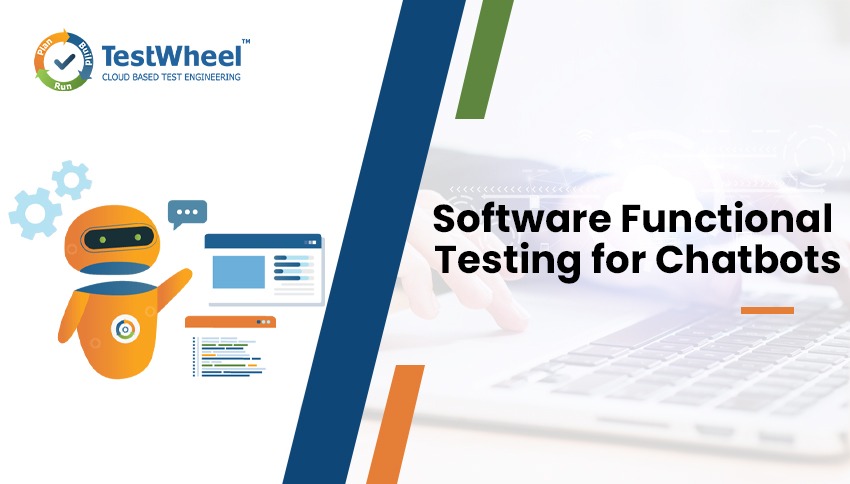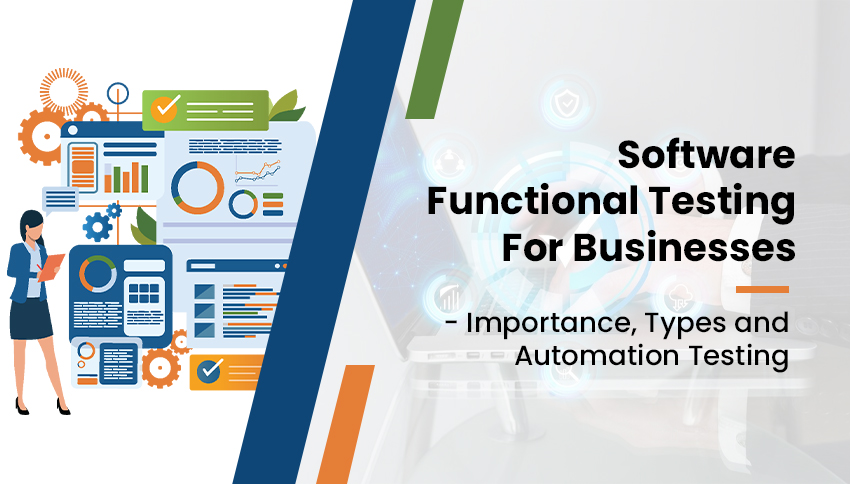- July 4, 2024

Chatbots have become an indispensable part of user experience and many online sites. Users are also finding it easy and convenient to engage with chatbots, for the instantaneous responses it offers. According to a recent research study, the use of chatbots has increased by more than 90% since 2019. As its usage has become extensive, there comes the need to ensure that chatbots deliver accurate and error-free information. As more and more businesses embrace the power of chatbots that are driven by artificial intelligence, there comes the need to rigorously test them to enhance customer experience.
Table of Contents
What is Software Functional Testing for Chatbots?
So, what exactly is software functional testing for chatbots? Well, just like any other software or application, chatbots need to undergo a series of rigorous tests to ensure they function optimally and meet their specifications. Testing is a crucial step that helps measure the effectiveness, functionality, and performance of the chatbots.
Software functional testing for generative AI-enabled chatbots delves into the intricate details of their functionality to ensure they provide accurate responses. The chatbots are put through a rigorous testing process to ensure they comprehend the customer’s intentions and respond appropriately, fostering meaningful business value. This testing involves simulating real-world interactions to identify any errors, limitations, harms, or risks in the chatbots’ performance.
Importance of Software Functional Testing for Chatbots
As chatbots are involved in rendering reliable and crucial user experiences and digital transitions, it is important to thoroughly test them for consistency in rendering advanced user experiences. They should be tested for their ability to integrate diverse functions and change the responses according to customer questions and requirements. Humans generally convey a message in a number of ways, and thus, chatbots should be able to process the input values promptly and deliver an appropriate reply. Thus, chatbot testing is important to ensure that businesses and customers get what they are looking for, free of any errors. and without risking organizational reputation. Other benefits of chatbot testing are as follows.
Improved user experiences
Functional testing of chatbots tests its intuitiveness and usability. Effective chatbot testing ensures that it is able to understand the intentions of humans correctly. It also ensures that the chatbot delivers relevant responses
Detects errors
Testing identifies the bugs in the interface that might be disrupting user interactions. It also ensures that the chatbot is able to detect inconsistencies in the conversation and handle edge cases and unexpected inputs appropriately.
Optimizes performance
Chatbot testing monitors its processing speed and response time to ensure that the tool can handle large volumes of data without lag.
Adaptability
Testing ensures the adaptability of the bot to handle diverse input languages and it also ensures that the bot is able to adapt to new user trends
Increases Efficiency
Functional testing enhances the efficiency of chatbots, which can save time for both users and businesses.
Saves Cost
As software functional testing addresses issues that help avoid costly errors, chatbot testing helps to save resources and enhance ROI. This can be achieved by integrating the Large Language Model (LLM) into the chatbots where the cost of tokens can significantly impact operational expenses.
Improve Security
Rigorous software testing helps safeguard user trust and privacy by ensuring the confidentiality of all interactions and sensitive data. It also makes sure the chatbot’s LLM integration performs responsibly in the aspect of user experience.
Different Techniques for AI Chatbot Functional Testing
Before deploying a chatbot, it is mandatory to conduct thorough testing to ensure its usability, performance, functionality, and security. The different techniques employed in the process of AI chatbot testing are as follows.

Security Testing
Security testing encompasses a detailed assessment of the defensive mechanism of the chatbot to identify its potential vulnerabilities. This will also include VAPT testing, running authentication checks, and performing encryption analysis. Security testing also encompasses running authentication checks to verify the resilience of the chatbot for potential breaches. Security testing mitigates the risks of financial losses for the company and also eliminates the legal consequences secondary to security breaches. As it ensures that the data is well encrypted, it also helps prevent unauthorized access
A/B Testing
A/B testing is one of the most powerful techniques of AI chatbot testing. In this technique, professionals compare the two versions of the chatbot to ascertain which approach drives better performance. They collect and test extensive data that determines the impact of both these approaches in A/B testing. This type of testing offers them crucial data to identify which version of the chatbot performs better based on real-time interactions.
User Acceptance Testing
The ultimate aim of this type of testing is to deliver an intuitive user experience. Experts will test not just the technological adeptness of chatbots but also measure how best they resonate with the interests of the target audience. The main advantage of acceptance testing is that it emphasizes creating user-friendly designs for optimal functionality and responsiveness. It also detects glitches and inconsistencies early and ensures prompt upgradation.
RAG Testing
RAG Testing (Retrieval Augmented Generation) is crucial for chatbots that are integrated with LLM. It evaluates the AI chatbot’s ability to retrieve and respond the information. The key benefits of RAG testing are assessing the chatbot’s retrieval accuracy, information integration, hallucination prevention, and context preservation. This process helps to maintain the chatbot’s response accuracy.
Regression Testing
Regression testing aims to ensure that the new changes and updates in the website do not affect the functionalities of the chatbot. This testing focuses on detecting the regression so that the quality assurance team is able to address and resolve them appropriately. It also boosts the confidence in the chatbot and assures the stability of the bots, during the development process.
Challenges and Solutions in Software Functional Testing for Chatbots
Testing chatbots comes with its own set of challenges that might have a serious impact on the user experience. Some of the common challenges that analysts face during the functional testing of chatbots are,
Natural Language Understanding
It is crucial to understand that the chatbot understands and processes the user inputs. Though different users use different languages and dialects, for the same dialect, testing should thus cover a range of expressions and phrases to make sure that the chatbot interprets them appropriately.
Contextual Understanding
The chatbot must maintain the same contact throughout the conversation to render appropriate responses. This demands accuracy in remembering and referencing past interactions. Testing should throw due light on how well the bot handles multi-turn conversations so that it can keep track of the context to respond promptly.
Handling User Input
At times, users might render ambiguous inputs, but the chatbot should be able to handle them effectively. It should be able to handle abbreviations, typos, and also incomplete sentences. Chatbots should also be tested on how well they are able to handle out-of-scope questions.
Scalability
Testing should be done to learn how well the chatbot functions under high user loads. Potential bottlenecks that hamper its efficiency should be identified.
Metrics to Track While Evaluating Chatbot Performance
Tracking the right metrics is mandatory for effective chatbot testing. Its key performance indicators are response accuracy, response time, and user retention rates. User satisfaction and engagement rates should also be measured and tracked to enhance the efficiency of the chatbot on the website. All these metrics can be assessed by collecting feedback from the audience and by measuring how often they return to the website to interact with the chatbot.
Tools Used for Testing Chatbots
The following are the tools that help to ascertain if the chatbot is capable of delivering a consistent user experience, regardless of the number of users interacting with it at the same time.
- Cyara: This testing platform makes use of regression testing and also tests the language processing and conversation analysis competencies of chatbots.
- Botium: This is one of the best solutions that supports multiple platforms for testing chatbots in various environments.
- Chatbottest: This is a specialized test that has been specifically designed for chatbot testing. It plays a significant role in validating the AI chatbot functionalities.
- Selenium: Functional testing for chatbots using Selenium helps to validate the interactions of the chatbot on different web platforms.
- TestFairy: This tool helps in regression testing of bots to validate their compatibility with different operating systems and mobile devices.
- Botanalytics: This is a very popular tool for testing conversational bots. It helps enhance human-to-bot conversation by locating bottlenecks and segmenting users and conversations, thus enhancing engagement.
The Excellence of TestWheel’s Functional Testing
Test Wheel’s software functional testing of chatbots will help in generating a comprehensive analysis of the current chatbot employed in the website. Being one of the distinguished software testing companies, Test Wheel has been rendering incredible chatbot testing and validating solutions to a range of global clients. They extensively focus on the crucial aspects of chatbot testing and offer custom solutions for our client’s software testing needs. Their seasoned QA experts make use of high-performance chatbot testing tools to enhance every aspect of the user experience. TestWheel expert team delivers high-quality, reliable testing solutions using advanced tools and industry-driven capabilities to ensure optimal results

